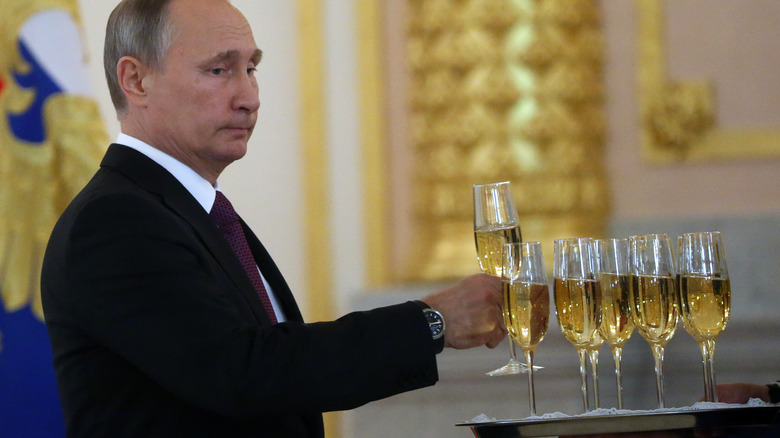How Stalin's Cheap Champagne Took Over The Soviet Union
Champagne has a long history with royalty and celebrations, dating back to the 18th-century parties thrown by French king Louis XV and his mistress Madame de Pompadour, notes VinePair. But Champagne's fancy aristocratic reputation has occasionally been subverted by leaders of a different ideological bent, from U.S. President George Washington to autocratic Soviet Union leader Joseph Stalin. The latter actually developed a thriving Soviet Champagne industry, per Atlas Obscura, largely as a propaganda move to show that the Soviet proletariat had easy access to perceived luxury items like Champagne and chocolate.
Somewhat ironically, Stalin's push to jumpstart a Soviet sparkling wine industry occurred during the 1930s, when, as Britannica observes, nearly every nation on the globe was feeling the effects of a historic economic depression. The Soviet Union certainly wasn't exempt from difficult economic circumstances. In fact, Stalin's ambitious goal of turning out a million bottles of Soviet Champagne per year — given official approval in 1936, per Atlas Obscura — came on the heels of a devastating nationwide famine.
Rather than using the traditional and time-consuming French method for making Champagne — in the Méthode Champenoise, explains Masterclass, the wine acquires its bubbly effervescence via a secondary fermentation after bottling — Soviet winemaker Anton Frolov-Bagreyev utilized his own cheap and expeditious variation of the tank method to churn out sweet Sovetskoye Shampanskoye in massive quantities of up to 10,000 liters per batch, per Atlas Obscura.
The enduring appeal of Soviet Shampanskoye
Frolov-Bagreyev's large-scale methods helped Stalin achieve his dream of a sparkling wine that was accessible to the proletariat; even as Atlas Obscura observes, ambitious Soviet quotas often outpaced production. But the scope of the quotas, which rose from one million bottles in 1936 to 12 million by 1942, ensured more vineyards were planted, and increasingly more bottles were made available for consumption.
Shampanskoye in the Soviet Union became synonymous with celebrations, just as Champagne has throughout the world. But the two sparkling wines were never close in terms of quality, confirms Atlas Obscura. Shampanskoye has traditionally been made using industrial production methods, with preservatives or sweeteners sometimes added. After the Soviet era ended in 1992, per Britannica, Russian winemakers continued to produce Shampanskoye. But by 2011, they were intent on changing the name, believing it was important to respect the French Champagne appellation while they were developing their own version series of wine appellations, notes Decanter.
A decade later, however, France and Russia continue to be at odds over the latter's use of the name Shampanskoye. According to The Guardian, Russian President Vladimir Putin has complicated issues even further by giving legal protection to the name and insisting French Champagne houses label their Russian imports as sparkling wine. So nearly 90 years after Stalin vowed to make Shampanskoye widely available in Russia, it still is ... just without the Sovietskoye attached.

